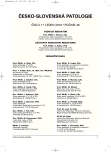Histopathological Classification of Idiopathic Interstitial Pneumonias
Authors:
C. Povýšil
Authors‘ workplace:
Ústav patologie 1. LF UK a VFN a Katedra patologické anatomie IPVZ, Praha
Published in:
Čes.-slov. Patol., 46, 2010, No. 1, p. 3-7
Category:
Reviews Article
Overview
The classification scheme of interstitial lung diseases has undergone numerous revisions. The criteria for distinguishing seven distinct subtypes of idiopathic interstitial pneumonias are now well defined by consensus in the recently published ATS/ERS classification of these lung diseases. In our present review the histological patterns of the different types are described and the differential diagnosis of idiopathic interstitial pneumonias is discussed.
Surgical lung biopsy remains the gold standard for the diagnosis of interstitial pneumonias, and sampling from at least 2 sites is recommended. Video-assisted thoracoscopic surgical biopsy is the preferred method for obtaining lung tissue as this procedure offers a similar yield as an open thoracotomy
The most common histological subtype of chronic interstitial lung disease is the usual interstitial pneumonia [UIP] which makes up 47-71% of cases. The key histologic features include patchy subpleural and paraseptal distribution of remodeling lung architecture with dense fibrosis, frequent honeycombing, and large fibroblastic foci. Temporal and spatial heterogeneity are the hallmarks.
Nonspecific interstitial pneumonia [NSIP] occurs primarily in middle-aged women who have never smoked, with more than 5-years survival rate in 80% of patients. The major feature of NSIP is a uniform interstitial thickening of alveolar septa by a fibrosing or cellular process.
The cardinal histological feature in respiratory bronchiolitis and desquamative pneumonia is an excess of intraalveolar histiocytes. In both patterns, there is variable interstitial fibrosis and chronic inflammation, and a strong association with a history of smoking.
Organizing pneumonia (idiopathic bronchiolitis obliterans-organizing pneumonia [BOOP]) is not strictly an interstitial process, because the alveoli and bronchioles are filled by intraluminal polyps of fibroblastic tissue and the expansion of the interstitium is mild.
Lymphocytic interstitial pneumonia [LIP] is currently viewed as a pattern of diffuse reactive pulmonary hyperplasia associated in most cases with EB virus, immunosuppression, or a connective tissue disorder. Malignant transformation may rarely occur. A dense mixed interstitial lymphoid infiltrate is a typical histological finding.
Diffuse alveolar damage [DAD] from unknown causes is termed acute interstitial pneumonia [AIP], and is synonymous with cases of Hamman-Rich disease. Hyaline membranes in the exsudative phase and marked expansion of the interstitium later are present.
Key words:
classification – histopathology – differential diagnosis – idiopathic interstitial pneumonia
Sources
1. American Thoracic Society/European Respiratory Society: International multidisciplinary consensus classification of the idiopathic interstitial pneumonias. Am. J. Respir. Crit. Care Med. 165, 2002, 277–304.
2. Craig, P.J., Wells, A.U., Hoffman, S. et al.: Desquamative interstitial pneumonia, respiratory bronchiolitis and their relationship to smoking. Histopathology, 45, 2004, 275–282.
3. Cheung, O.Y., Chan, J.W.M., Ng, C.K. et al.: The spectrum of pathological changes in severe acute respiratory syndrome (SARS). Histopathology, 45, 2004, 119–124.
4. Gordon, I.O., Cipriani, N., Arif, Q.: Update in nonneoplastic lung diseases. Arch. Pathol. Lab. Med. 133, 2009, 1096–1105.
5. Katzenstein, AL.A., Fiorelli, R.F.: Nonspecific interstitial pneumonia/fibrosis: histologic features and clinical significance. Am. J. Surg. Pathol. 18, 1994, 136–147.
6. Katzenstein, AL.A., Zisman, D.A., Litzky, L.A. et al.: Usual interstitial pneumonia. Histologic study of biopsy and explant specimens. Am. J. Surg. Pathol. 26, 2002, 1567–1577.
7. Liebow, A.A., Carrington, C.B.: The interstitial pneumonias. In: Simon, M., Potchen, E.J., Lemay, E., ed. Frontiers in pulmonary radiology. New York: Grune and Stratton, 1969, s. 102–141.
8. Leslie, K.O.: My approach to interstitial lung disease using clinical, radiological and histopathological patterns. J. Clin. Pathol. 62, 2009, 387–401.
9. Nicholson, A. G.: Classification of idiopathic interstitial pneumonias: making sense of the alphabet soup. Histopathology 41, 2002, 381–391.
10. White, E.S., Lazar, M.H., Thannickal, V.J.: Pathogenetic mechanisms in usual interstitial pneumonia/idiopathic pulmonary fibrosis. J. Pathol. 201, 2003, 343–354.
Labels
Anatomical pathology Forensic medical examiner ToxicologyArticle was published in
Czecho-Slovak Pathology

2010 Issue 1
Most read in this issue
- Histopathological Classification of Idiopathic Interstitial Pneumonias
- Lymphoma of the Small Intestine
- Caspase 1, Superoxiddismutase (D-mutase) and Calretinin Expression in the Placenta and in the Basal Decidua in Preeclampsia
- Analysis of Bone Marrow Angiogenesis in Multiple Myeloma
